Design Thinking Stages and Braussie Mobile Bar Presentation Analysis
VerifiedAdded on 2022/07/28
|6
|1035
|23
Presentation
AI Summary
This presentation analyzes the application of the design thinking process to the Braussie Mobile Bar project. It systematically explores each stage of design thinking, including Empathize, Define, Ideate, Prototype, and Test. The presentation details the activities and outcomes of each stage, such as the creation of an empathy map, problem statement, and mind map. The analysis includes a discussion of the challenges encountered during each stage and the solutions developed. The final stage focuses on the testing of the mobile bar concept, considering customer needs and potential improvements. The presentation aims to provide a clear understanding of how design thinking can be used to develop and improve a mobile bar business model in Australia.
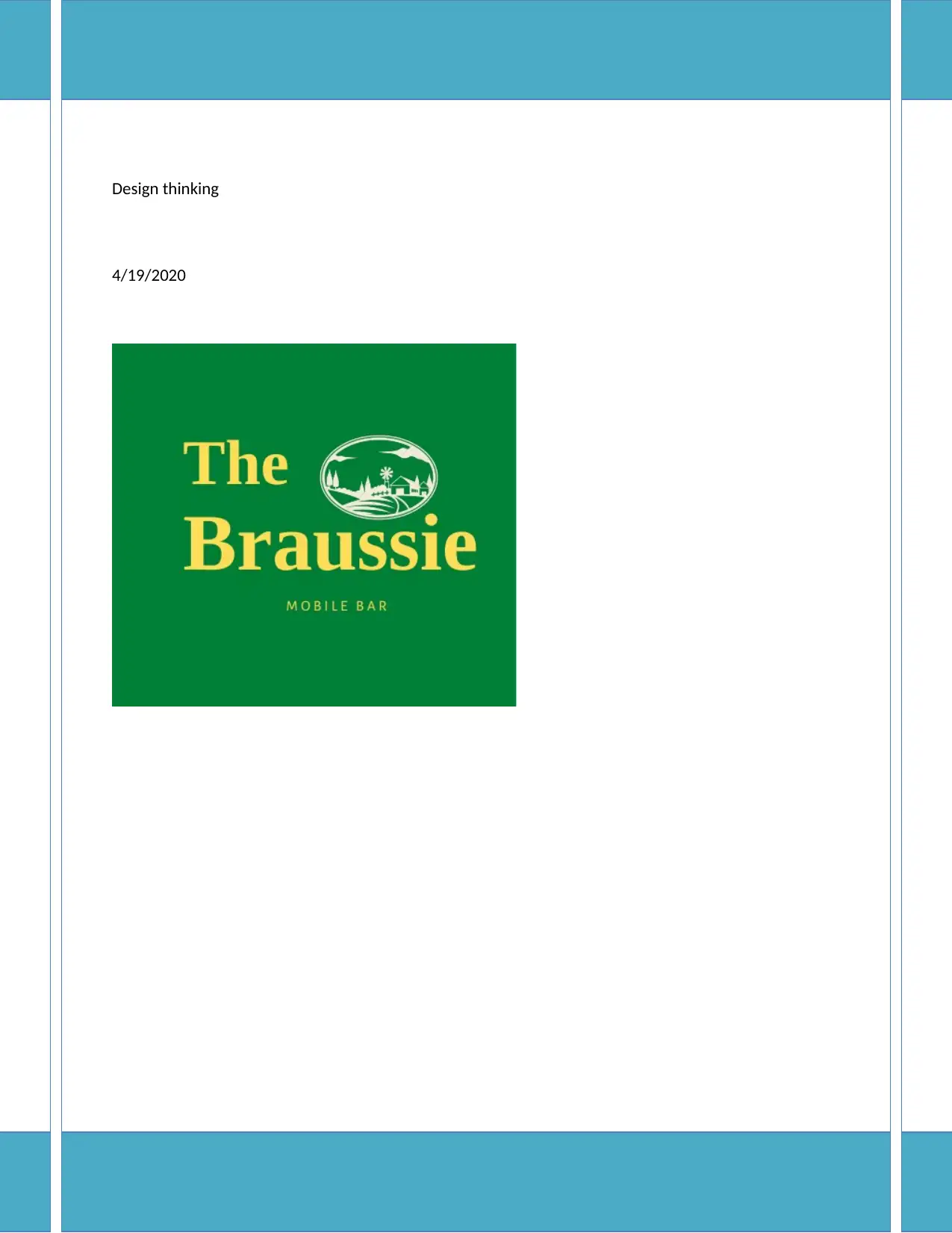
Design thinking
4/19/2020
4/19/2020
Paraphrase This Document
Need a fresh take? Get an instant paraphrase of this document with our AI Paraphraser
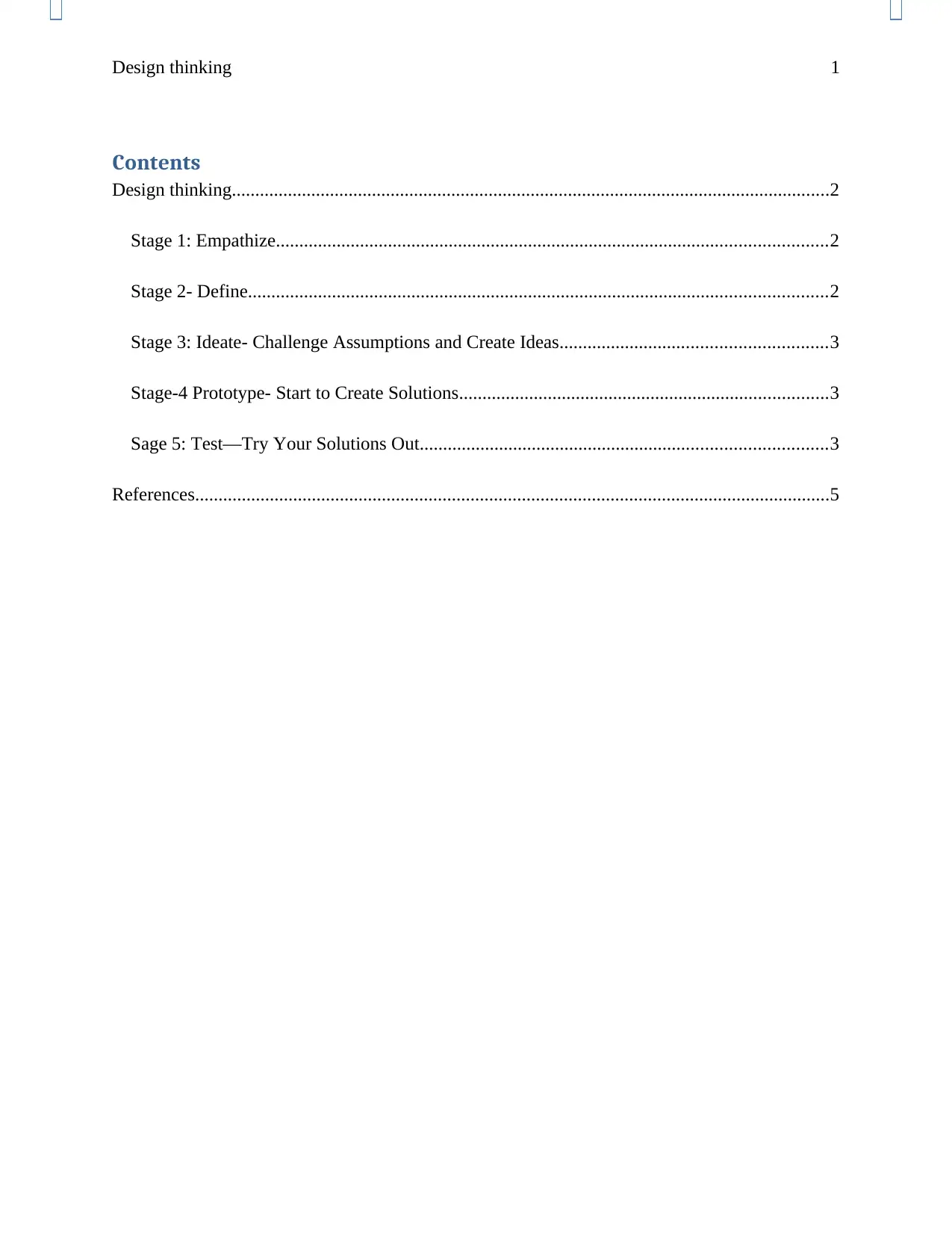
Design thinking 1
Contents
Design thinking................................................................................................................................2
Stage 1: Empathize......................................................................................................................2
Stage 2- Define............................................................................................................................2
Stage 3: Ideate- Challenge Assumptions and Create Ideas.........................................................3
Stage-4 Prototype- Start to Create Solutions...............................................................................3
Sage 5: Test—Try Your Solutions Out.......................................................................................3
References........................................................................................................................................5
Contents
Design thinking................................................................................................................................2
Stage 1: Empathize......................................................................................................................2
Stage 2- Define............................................................................................................................2
Stage 3: Ideate- Challenge Assumptions and Create Ideas.........................................................3
Stage-4 Prototype- Start to Create Solutions...............................................................................3
Sage 5: Test—Try Your Solutions Out.......................................................................................3
References........................................................................................................................................5
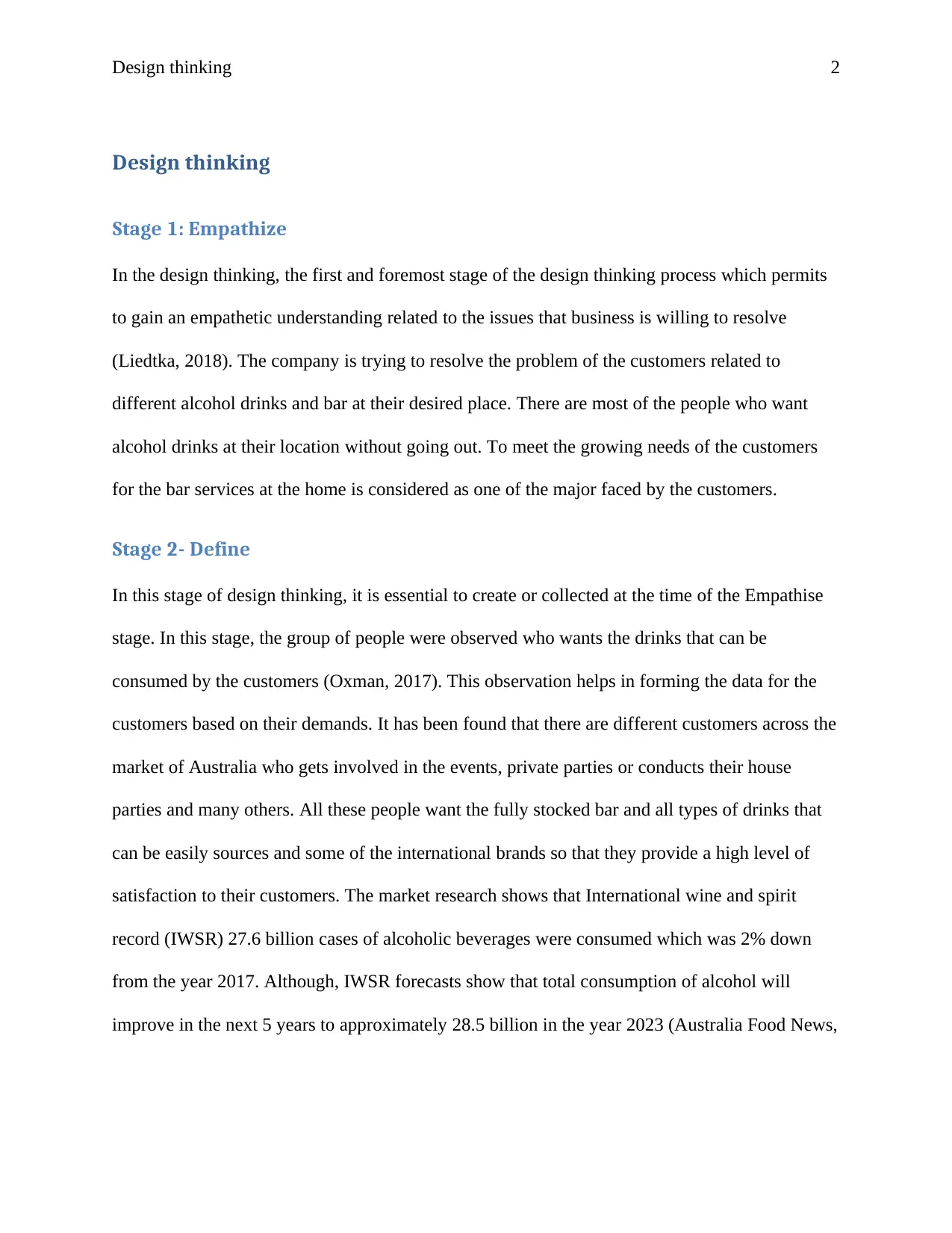
Design thinking 2
Design thinking
Stage 1: Empathize
In the design thinking, the first and foremost stage of the design thinking process which permits
to gain an empathetic understanding related to the issues that business is willing to resolve
(Liedtka, 2018). The company is trying to resolve the problem of the customers related to
different alcohol drinks and bar at their desired place. There are most of the people who want
alcohol drinks at their location without going out. To meet the growing needs of the customers
for the bar services at the home is considered as one of the major faced by the customers.
Stage 2- Define
In this stage of design thinking, it is essential to create or collected at the time of the Empathise
stage. In this stage, the group of people were observed who wants the drinks that can be
consumed by the customers (Oxman, 2017). This observation helps in forming the data for the
customers based on their demands. It has been found that there are different customers across the
market of Australia who gets involved in the events, private parties or conducts their house
parties and many others. All these people want the fully stocked bar and all types of drinks that
can be easily sources and some of the international brands so that they provide a high level of
satisfaction to their customers. The market research shows that International wine and spirit
record (IWSR) 27.6 billion cases of alcoholic beverages were consumed which was 2% down
from the year 2017. Although, IWSR forecasts show that total consumption of alcohol will
improve in the next 5 years to approximately 28.5 billion in the year 2023 (Australia Food News,
Design thinking
Stage 1: Empathize
In the design thinking, the first and foremost stage of the design thinking process which permits
to gain an empathetic understanding related to the issues that business is willing to resolve
(Liedtka, 2018). The company is trying to resolve the problem of the customers related to
different alcohol drinks and bar at their desired place. There are most of the people who want
alcohol drinks at their location without going out. To meet the growing needs of the customers
for the bar services at the home is considered as one of the major faced by the customers.
Stage 2- Define
In this stage of design thinking, it is essential to create or collected at the time of the Empathise
stage. In this stage, the group of people were observed who wants the drinks that can be
consumed by the customers (Oxman, 2017). This observation helps in forming the data for the
customers based on their demands. It has been found that there are different customers across the
market of Australia who gets involved in the events, private parties or conducts their house
parties and many others. All these people want the fully stocked bar and all types of drinks that
can be easily sources and some of the international brands so that they provide a high level of
satisfaction to their customers. The market research shows that International wine and spirit
record (IWSR) 27.6 billion cases of alcoholic beverages were consumed which was 2% down
from the year 2017. Although, IWSR forecasts show that total consumption of alcohol will
improve in the next 5 years to approximately 28.5 billion in the year 2023 (Australia Food News,
⊘ This is a preview!⊘
Do you want full access?
Subscribe today to unlock all pages.

Trusted by 1+ million students worldwide
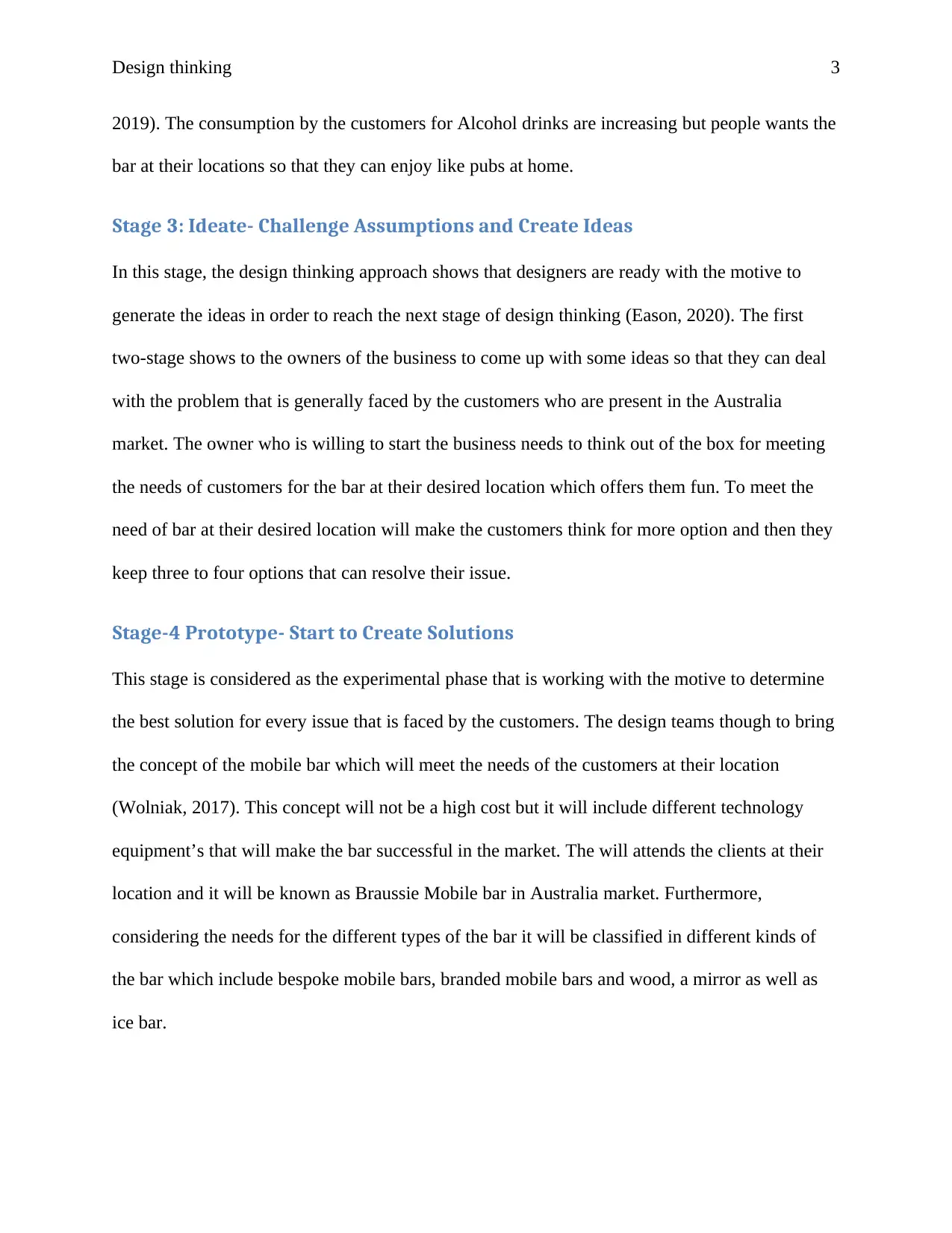
Design thinking 3
2019). The consumption by the customers for Alcohol drinks are increasing but people wants the
bar at their locations so that they can enjoy like pubs at home.
Stage 3: Ideate- Challenge Assumptions and Create Ideas
In this stage, the design thinking approach shows that designers are ready with the motive to
generate the ideas in order to reach the next stage of design thinking (Eason, 2020). The first
two-stage shows to the owners of the business to come up with some ideas so that they can deal
with the problem that is generally faced by the customers who are present in the Australia
market. The owner who is willing to start the business needs to think out of the box for meeting
the needs of customers for the bar at their desired location which offers them fun. To meet the
need of bar at their desired location will make the customers think for more option and then they
keep three to four options that can resolve their issue.
Stage-4 Prototype- Start to Create Solutions
This stage is considered as the experimental phase that is working with the motive to determine
the best solution for every issue that is faced by the customers. The design teams though to bring
the concept of the mobile bar which will meet the needs of the customers at their location
(Wolniak, 2017). This concept will not be a high cost but it will include different technology
equipment’s that will make the bar successful in the market. The will attends the clients at their
location and it will be known as Braussie Mobile bar in Australia market. Furthermore,
considering the needs for the different types of the bar it will be classified in different kinds of
the bar which include bespoke mobile bars, branded mobile bars and wood, a mirror as well as
ice bar.
2019). The consumption by the customers for Alcohol drinks are increasing but people wants the
bar at their locations so that they can enjoy like pubs at home.
Stage 3: Ideate- Challenge Assumptions and Create Ideas
In this stage, the design thinking approach shows that designers are ready with the motive to
generate the ideas in order to reach the next stage of design thinking (Eason, 2020). The first
two-stage shows to the owners of the business to come up with some ideas so that they can deal
with the problem that is generally faced by the customers who are present in the Australia
market. The owner who is willing to start the business needs to think out of the box for meeting
the needs of customers for the bar at their desired location which offers them fun. To meet the
need of bar at their desired location will make the customers think for more option and then they
keep three to four options that can resolve their issue.
Stage-4 Prototype- Start to Create Solutions
This stage is considered as the experimental phase that is working with the motive to determine
the best solution for every issue that is faced by the customers. The design teams though to bring
the concept of the mobile bar which will meet the needs of the customers at their location
(Wolniak, 2017). This concept will not be a high cost but it will include different technology
equipment’s that will make the bar successful in the market. The will attends the clients at their
location and it will be known as Braussie Mobile bar in Australia market. Furthermore,
considering the needs for the different types of the bar it will be classified in different kinds of
the bar which include bespoke mobile bars, branded mobile bars and wood, a mirror as well as
ice bar.
Paraphrase This Document
Need a fresh take? Get an instant paraphrase of this document with our AI Paraphraser
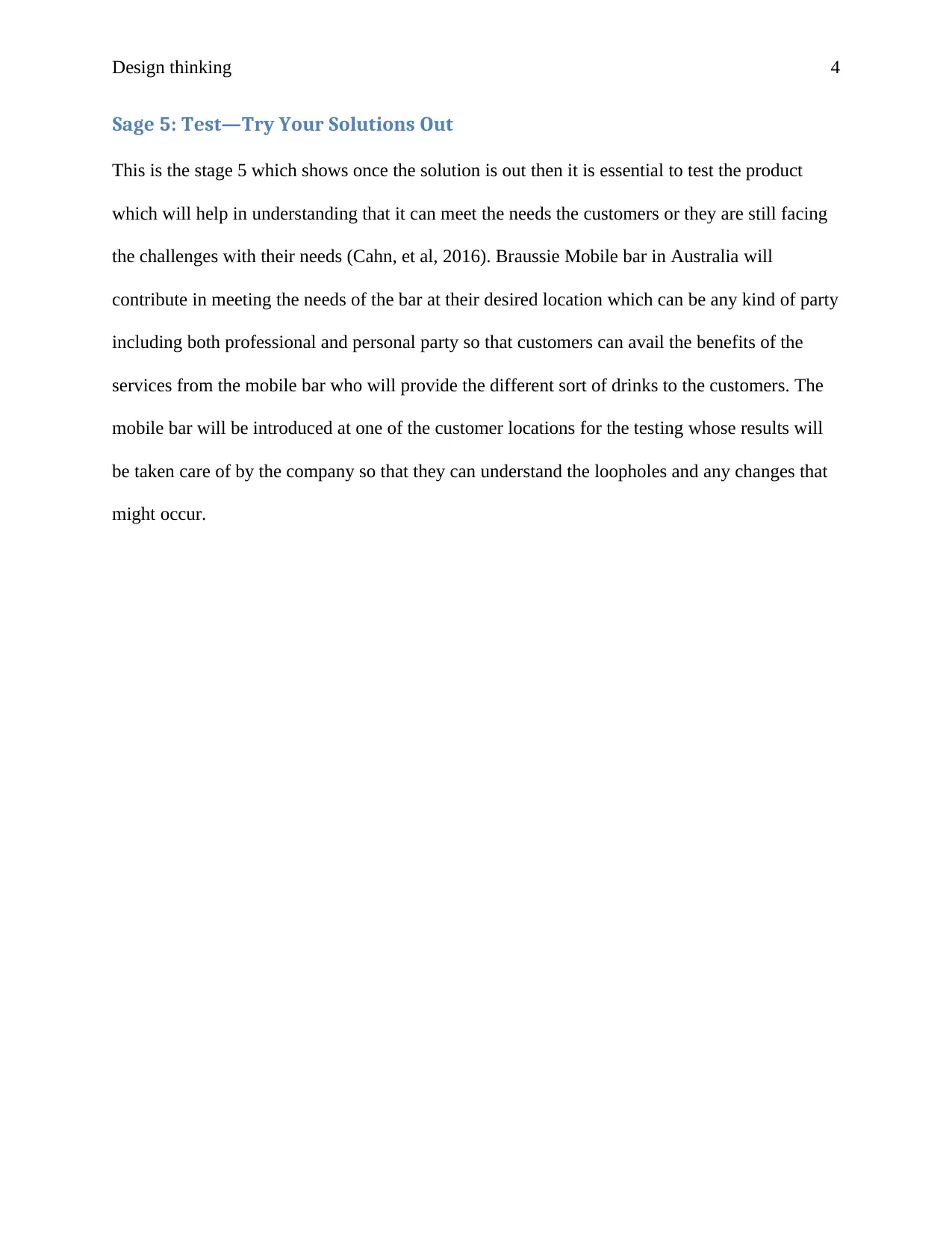
Design thinking 4
Sage 5: Test—Try Your Solutions Out
This is the stage 5 which shows once the solution is out then it is essential to test the product
which will help in understanding that it can meet the needs the customers or they are still facing
the challenges with their needs (Cahn, et al, 2016). Braussie Mobile bar in Australia will
contribute in meeting the needs of the bar at their desired location which can be any kind of party
including both professional and personal party so that customers can avail the benefits of the
services from the mobile bar who will provide the different sort of drinks to the customers. The
mobile bar will be introduced at one of the customer locations for the testing whose results will
be taken care of by the company so that they can understand the loopholes and any changes that
might occur.
Sage 5: Test—Try Your Solutions Out
This is the stage 5 which shows once the solution is out then it is essential to test the product
which will help in understanding that it can meet the needs the customers or they are still facing
the challenges with their needs (Cahn, et al, 2016). Braussie Mobile bar in Australia will
contribute in meeting the needs of the bar at their desired location which can be any kind of party
including both professional and personal party so that customers can avail the benefits of the
services from the mobile bar who will provide the different sort of drinks to the customers. The
mobile bar will be introduced at one of the customer locations for the testing whose results will
be taken care of by the company so that they can understand the loopholes and any changes that
might occur.
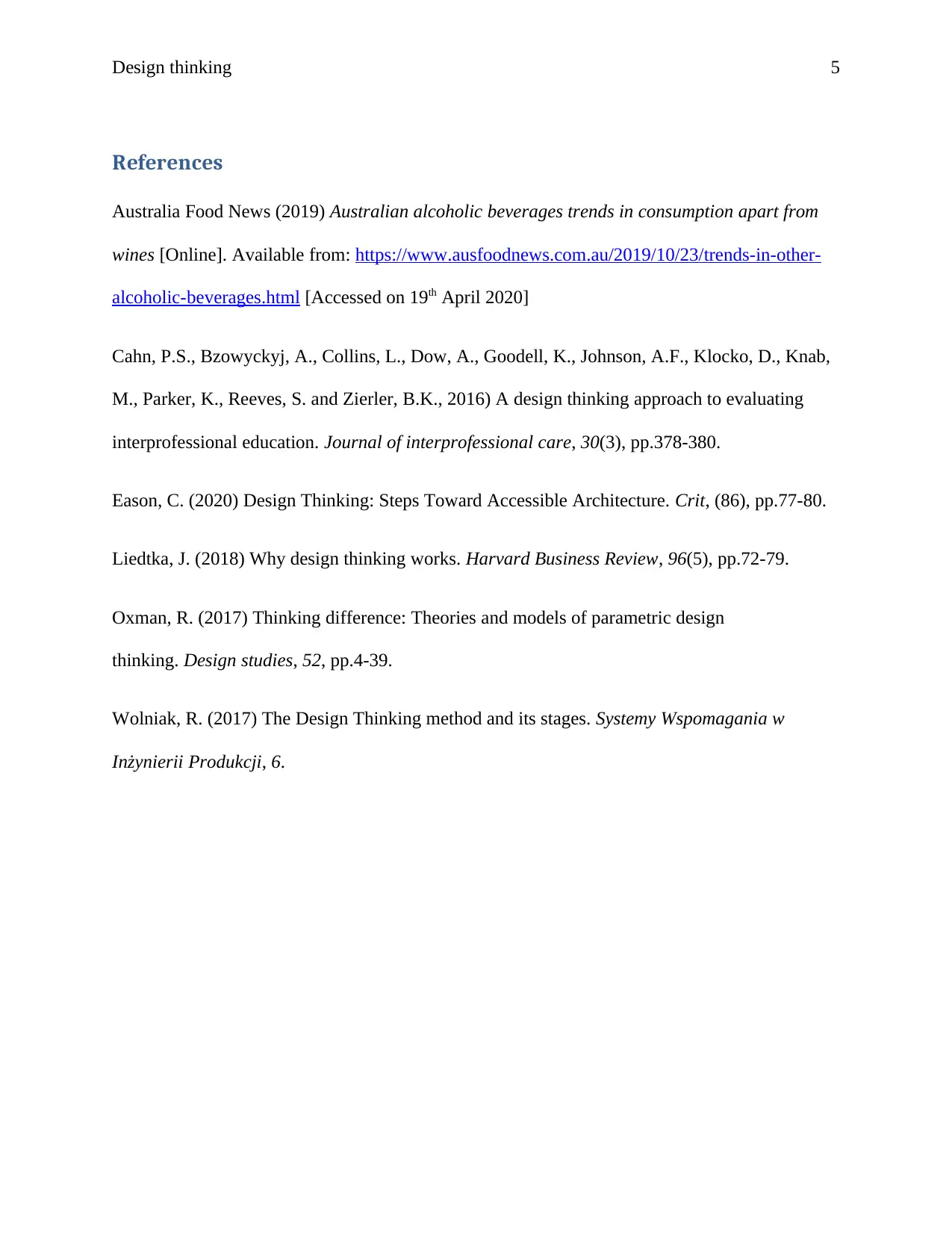
Design thinking 5
References
Australia Food News (2019) Australian alcoholic beverages trends in consumption apart from
wines [Online]. Available from: https://www.ausfoodnews.com.au/2019/10/23/trends-in-other-
alcoholic-beverages.html [Accessed on 19th April 2020]
Cahn, P.S., Bzowyckyj, A., Collins, L., Dow, A., Goodell, K., Johnson, A.F., Klocko, D., Knab,
M., Parker, K., Reeves, S. and Zierler, B.K., 2016) A design thinking approach to evaluating
interprofessional education. Journal of interprofessional care, 30(3), pp.378-380.
Eason, C. (2020) Design Thinking: Steps Toward Accessible Architecture. Crit, (86), pp.77-80.
Liedtka, J. (2018) Why design thinking works. Harvard Business Review, 96(5), pp.72-79.
Oxman, R. (2017) Thinking difference: Theories and models of parametric design
thinking. Design studies, 52, pp.4-39.
Wolniak, R. (2017) The Design Thinking method and its stages. Systemy Wspomagania w
Inżynierii Produkcji, 6.
References
Australia Food News (2019) Australian alcoholic beverages trends in consumption apart from
wines [Online]. Available from: https://www.ausfoodnews.com.au/2019/10/23/trends-in-other-
alcoholic-beverages.html [Accessed on 19th April 2020]
Cahn, P.S., Bzowyckyj, A., Collins, L., Dow, A., Goodell, K., Johnson, A.F., Klocko, D., Knab,
M., Parker, K., Reeves, S. and Zierler, B.K., 2016) A design thinking approach to evaluating
interprofessional education. Journal of interprofessional care, 30(3), pp.378-380.
Eason, C. (2020) Design Thinking: Steps Toward Accessible Architecture. Crit, (86), pp.77-80.
Liedtka, J. (2018) Why design thinking works. Harvard Business Review, 96(5), pp.72-79.
Oxman, R. (2017) Thinking difference: Theories and models of parametric design
thinking. Design studies, 52, pp.4-39.
Wolniak, R. (2017) The Design Thinking method and its stages. Systemy Wspomagania w
Inżynierii Produkcji, 6.
⊘ This is a preview!⊘
Do you want full access?
Subscribe today to unlock all pages.

Trusted by 1+ million students worldwide
1 out of 6
Related Documents
Your All-in-One AI-Powered Toolkit for Academic Success.
+13062052269
info@desklib.com
Available 24*7 on WhatsApp / Email
![[object Object]](/_next/static/media/star-bottom.7253800d.svg)
Unlock your academic potential
Copyright © 2020–2025 A2Z Services. All Rights Reserved. Developed and managed by ZUCOL.





